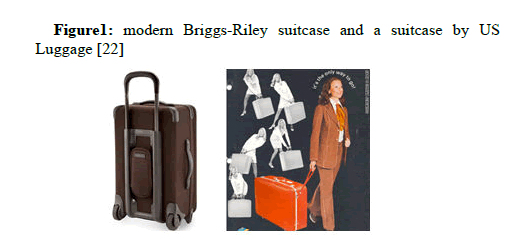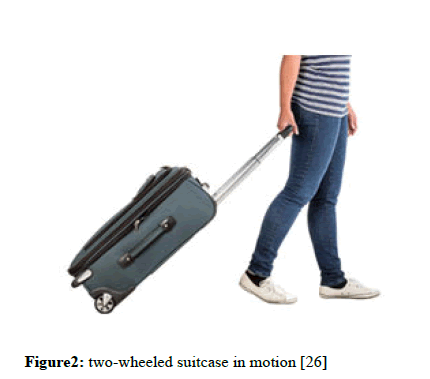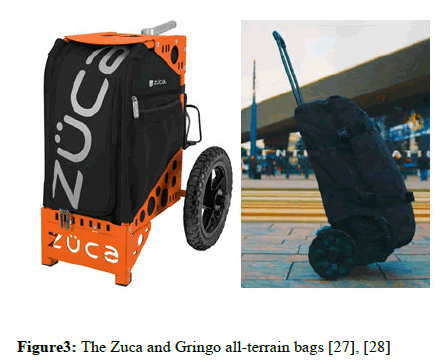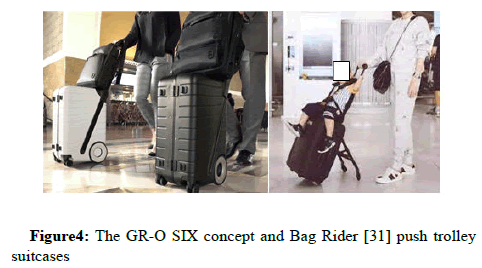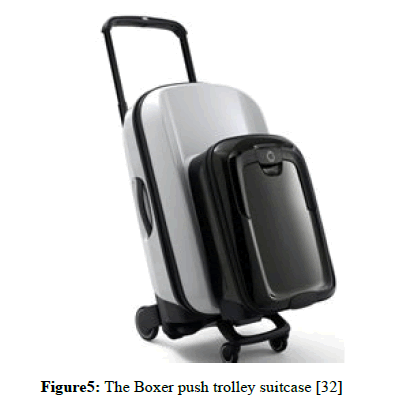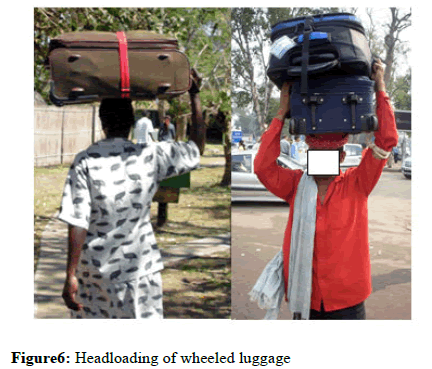Review Article, J Ergon Res Vol: 4 Issue: 6
A Review on the Usability of Wheeled Luggage
Daniel Chitena*, Albert Uchenna Ude, Vivekanandhan Chinnasamy, Zeundjua Tjiparuro
Department of Mechanical, Energy, Industrial and Manufacturing Engineering, BIUST, Private Bag 16, Palapye, Botswana, Africa
- *Corresponding Author:
- Daniel Chitena
Department of Mechanical,
Energy, Industrial and Manufacturing Engineering,
BIUST,
Private Bag 16,
Palapye,
Botswana,
Africa,
Tel no: 26773671034;
E-mail: daniel.chitena@studentmail.biust.ac.bw
Received date: August 14, 2021; Accepted date: November 18, 2021; Published date: November 29, 2021
Citation:Chitena D, Ude AU, Chinnasamy V, Tjiparuro Z (2021) A Review on the Usability of Wheeled Luggage. J Ergon Res 04:6.
Abstract
Wheeled luggage use is rising and its ergonomics should be improved to minimise workload and injury. Only six ergonomic studies could be found and they only covered pulled two-wheel luggage. Most researchers have focused on industrial carts. Previous studies recommend that wheeled luggage be treated as a material handling aid. Four main types of wheeled luggage are identified. Pulled wheeled luggage has been found to have ergonomic flaws such as too much stress on the pulling arm and awkward postures. Design analysis shows that most wheeled luggage is unsuitable for the developing world because of low usability on poor terrain. Larger wheels can address some of the concerns. Initial findings show that push- trolley luggage addresses some of the inadequacies. More studies are needed to determine the potential of push-trolley wheeled luggage and of wheeled luggage for the developing world. Wheeled luggage is suggested as a solution to headloading and drudgery.
Keywords: Wheeled luggage; luggage ergonomics; luggage design; Intermediate Means of Transport
Introduction
Wheeled luggage is considered in this study and in a few other existing studies as a material handling aid. Manual material handling refers to activities such as pushing, pulling, lifting or lowering loads [1]. Numerous studies have been carried out to optimise material handling aids in terms of ergonomics and performance e.g. [2], [3], [4], [5], [6], [7]. In most literature of industrial ergonomics the term material handling aids refers mostly to two and four-wheeled carts, trolleys, wheeled containers and wheel barrows. Most material handling aids are either pushed or pulled during use. Most ergonomic studies on material handling aids often reveal ergonomic inadequacies in the designs of the aids.
Material handling aids should be designed with ergonomics in mind to reduce workload and risk of musculoskeletal disorders. Manual material handling activities can lead to an increased risk of injuries in the neck and shoulders [8], [9], [10]. Excessive manual material handling can lead to increased risk of back injuries [11],[10].
There has been an increase in travel worldwide and this will result in an increase in the use of wheeled luggage. According to the United Nation World Tourism Organisation (UNWTO) 2019 was the tenth consecutive year of growth in international tourist arrivals and there was an estimated 1.1 billion international tourist arrivals in the first nine months of 2019, an increase of about 43 million from the same period in 2018. [12]. This has led to an increase in luggage use and luggage sales. According to a research consultancy firm called Statista the global market value of luggage in 2020 was $22.78 billion and is expected to be approximately $25.7 billion in 2024 [13]. However there are very few comprehensive studies specifically on wheeled luggage e.g. [14], [15], [16].
Most researchers have ignored wheeled luggage and focused on heavy duty industrial carts [16] despite the widespread use of wheeled luggage and reported injury due to luggage use. Myung et al. [17] found that two-wheeled pulled luggage has ergonomic shortfalls such as too much stress on the users during operation. As a consequence of the observed shortfalls two of the luggage studies concluded that pulled two-wheeled luggage is poorly designed and used [15],[16].
Usage of heavy luggage has the risk of musculoskeletal disorders [18], [15]. In the United States nearly 54,000 luggage-related injuries occurred in 2012 [19] while the number of people in who received treatment for luggage-related injuries in US emergency centres rose from 73000 in 2014 to 84000 in 2015 [20].
This review will seek to review previous wheeled luggage research studies and the most common commercial wheeled luggage designs. Recommendations on the design of wheeled luggage will be made based on the cited studies, observations of luggage use and analysis of the existing designs.
An overview of modern wheeled luggage
The patent application for the first commercially successful wheeled luggage, a wheeled suitcase was filed by Bernard David Sadow in 1970 [22]. Sadow is widely regarded as the inventor of modern commercial wheeled luggage but he was not the first to fit wheels on luggage. Sadow went into luggage business and at one time was an owner and president of a company called US Luggage [21]. US Luggage is the parent company of what is known today as Briggs & Riley [22]. Figure 1 shows two images: one of a modern Briggs- Riley wheeled suitcase and one of the initial suitcases made US Luggage.
Figure 1: modern Briggs-Riley suitcase and a suitcase by US Luggage [22]
Sadow’s wheeled suitcase had four castors underneath it and would be pulled via a leather strap on the side of the user. Consequently the suitcase would relieve the user of the burden of lifting the entire bag. The suitcase lessened the risks due to injury as a result of lifting and significantly reduced the effort required to transport luggage. However, because of the narrow base the suitcase was susceptible to tipping over, wobbly and difficult to use [21].
The main types of wheeled luggage are listed and discussed below
Pulled wheeled roller luggage
Pulled wheeled luggage is normally pulled from behind the user by a single arm as shown in Figure 2. Pulling is the most widely used means of moving wheeled luggage. By balancing the slanted bag on two wheels the user supports part of the load. Most of the wheels range between 5cm to 8cm in diameter. The volumes of commercial wheeled luggage bags vary greatly ranging from approximately 30 litres to about 170 litres.
Two-wheeled roller suitcases
A major breakthrough in the history of wheeled luggage occurred in 1987 when Robert Plath developed a standing wheeled two-wheeled suitcase with a retractable handle. He was granted the patent in 1991 [23]. He named it the “Rollaboard” and this suitcase marked the beginning of a luggage company called Travelpro [24] and quickly overtook Bernard Sadow’s suitcase in terms of popularity [25].
Two-wheeled suitcases are some of the most common types of luggage. They usually come with a telescopic handle which the user uses to pull. Figure 2 shows a medium-sized two-wheeled pulled suitcase with a retractable handle being pulled along.
Figure 2: two-wheeled suitcase in motion [26]
Two-wheeled duffel bags
Duffel bags are usually close to cylindrical in shape and designed to be carried over the shoulders. Some duffel bags are fitted with twowheels and also pulled from behind like in Figure 2. The largest duffle bags are among the most voluminous bags one can buy.
Two-wheeled backpacks
Backpacks are bags designed to be carried on the back usually secured onto the user’s shoulders by a pair of straps. Wheels have been fitted on some backpacks to enable the pulling of backpacks especially when they are too heavy for the back.
All-terrain bags
A few manufacturers and luggage designers have created twowheeled suitcases and duffel bags designed for rough outdoor environments. These bags usually have wheels much larger than the mostly 5-8cm diameter wheels found on convectional luggage and more ground clearance. Some of the wheels can sometimes be 20-30cm in diameter. One commercially available all-terrain luggage is from the brand called Zuca [27]. Zuca is the only luggage manufacturer that the authors found that offers dedicated all-terrain luggage for sale. Another concept called the Gringo all-terrain is yet to be widely available for commercial sale. The Gringo’s ground clearance can be adjusted to 3 positions. Figure 3 shows Zuca and a Gringo all-terrain bags and they have 30cm and 20cm diameter wheels respectively.
Spinner wheeled suitcases
In 2004 Samsonite released the world’s first four-wheeled spinner suitcase they named Sahora [29], [30]. This spinner suitcase design quickly became popular and common among travellers. Spinner suitcases are normally fitted with four castors (spinners) wheels at bottom which allow the suitcase to be pushed and pulled upright in any direction. The wheels can spin 360º. However the suitcases are usually pushed on good surfaces and then pulled on two wheels on rougher outdoor surfaces. They tend to be unstable on uneven terrain and often the wheels are so small that they get caught in cracks or bumps making spinner suitcases unsuitable for unpaved roads. The wheels on spinner suitcases tend to be smaller than those on twowheeled suitcases making them more susceptible to damage and higher rates of wear.
Push-trolley luggage
A new segment of wheeled luggage has emerged recently and in this study we refer to it as the push-trolley luggage segment. The push-trolley suitcases are designed specifically to be pushed in front of the user, mostly on four wheels. Push-trolley luggage is pushed in the similar manner shopping trolleys are pushed. The major advantage of this design over pulled luggage is that there is no weight load place on the user. Most push-trolley suitcases have one set of wheels (rear or front) swivelling to give the suitcase direction. Figure 4 shows some of the push trolley suitcases available for purchase. Despite the evident ergonomic advantages offered by push trolley suitcases compared to pulled luggage they remain a niche segment.
Figure 4: The GR-O SIX concept and Bag Rider [31] push trolley suitcases
Figure 5 shows the push trolley suitcase called the Boxer made by a company called Bugaboo. However its high price means it will remain a niche product and unattainable to a significant portion of luggage users. Like the Boxer most push trolley suitcases have the ability to transport other suitable suitcases as seen in Figure 5. The Bag Rider is able to carry a small child as seen in Figure 4.
Figure 5: The Boxer push trolley suitcase [32]
Smart luggage
According to one research consultant, “The term “smart luggage” is widely used for bags and suitcases with various tech-savvy features such as Wi-Fi hotspots, SIM cards, GPS, Bluetooth, RFID, built-in batteries, and digital scaling” [43]. Some smart bags have been motorised to enable independent movement and in some cases, they transport the user as well. Smart luggage generally tends to be much more expensive than other types of luggage.
Summary of existing luggage studies
Only six luggage usability studies could be found. Each of the six luggage studies is summarised in Table 1. Five studies looked at twowheeled suitcases only. No studies specifically on four-wheeled luggage could be found. Most studies on material handling aids focus on industrial carts. Two-wheeled luggage is considered light work therefore has not attracted much research. The operational dynamics of two-wheeled luggage is different to that of four-wheeled carts and deserves more research effort because the movement of two-wheeled luggage employs one hand instead of the two employed in fourwheeled carts [16].
| Study | Luggage Characteristics | Dependent variables | Independent |
|---|---|---|---|
| Lee 2006 [16]. A thesis | Two-wheeled suitcase | Pulling force, usability | Load, pole length/tilted angle, user characteristics |
| Jung 2004 [15]. A thesis | Two-wheeled carry on suitcase | Physical stress on users | Wheel diameter, load handle diameter, subject height, pole angle, COM, surface type |
| Jung et al. 2007 [14]. Based on 2004 thesis [15] | Two-wheeled carry on suitcase | Same as above | Same as above |
| Jung et al. 2003 [17] | Two-wheeled suitcase | Motion | Pole factors, load |
| Rose et al. [33] 2013 | Two-wheeled suitcase | Spine loading | Load weight, walking versus stationery subject |
| Pirruccio and Kelly 2020 [18] | All luggage types | Shoulder injuries | U.S data on user characteristics, injury mechanism, diagnosis |
Table1: summary of luggage studies
A summary of five of the six studies given in Table 1 is given below Pirrucio and Kelly
Pirrucio and Kelly [18] analyses the 2003-2017 records of the National Electronic Injury Surveillance System (NEISS) and compiles data on shoulder injuries reported to US emergency departments as a result of luggage use. They found that, on average, 1811 luggage induced injuries (at a 95% Confidence Interval of 1123 – 2499) were reported to US emergency departments. 70% of the shoulder injuries were caused by lifting luggage. Women were shown to be more susceptible to shoulder injuries accounting for an average of 62.3% of the injured.
Jung
Jung [15] compiled a thesis based on his study on the ergonomics of pulling two-wheeled suitcases. He conducted luggage pulling tests using four male subjects and measured stress and other biological factors. He proposed that the handle length be set at 110cm as the average luggage handle length of 100cm was less ergonomic than the 110cm length. The 110cm length resulted in less wrist joint force, and pulling force in the side directions. Luggage with an angled pole resulted in 12% less downward force at the handle. In the study larger wheels were observed to require 31% less downward force, 14% pulling force, 24% more sideward force and 6% less energy expenditure. Two luggage loads of 15kg and 23kg were tested. The right pulling arm was found to be the most affected by the load. The heavier load resulted in an increase in downward forces and forward pulling forces at the handle of 30% and 39% respectively leading to an increase of 8% in energy expenditure. A higher centre of gravity resulted in the increase of the downward force component by 44% and increase of the forward pulling force by about 184%. Luggage tests were conducted on carpeted surfaces and flat non-carpeted surfaces. Carpeting resulted in an increase in pulling force of 9%. Subject height was found to affect independent variables.
Jun-Seok
Jun-Seok [16] made several recommendations in his thesis study on the usability of two-wheeled luggage. He used mechanical models and usability on two prototypes to assess the design of two-wheeled luggage. He found that pole length significantly affects the back, wrist and arm and that for pole lengths above 125.73cm there was an increase in complaint scores on all body parts. The arm caused the most complaints amongst all the body parts during trials of twowheeled luggage use. He also observed that for luggage pole lengths below 97.79cm and above 133.35cm, the pulling force increased. Shorter subjects were said to feel higher pulling forces than taller subjects. Load weight and subjects’ knee knuckle height were found to affect the risk of tripping during the pulling of luggage.
Rose
Rose [33] measured spine loading during experiments which employed several different methods of carrying loads. The carrying of loads via a two-wheeled suitcase resulted in one of the lowest A/P shear forces of 389.6N with standard deviation (SD) of 131.3 for the 11.3kg load carrying walking task or experiment. Only the backpack method of an 11.3kg walking task produced a lower force.
Jung
Jung [17] studied two types of carry-on luggage focusing on the differences of handles (single curved pole versus double pole) under different conditions of load weights, subject posture and walking speeds. He found that single, curved and longer poles may benefit the luggage user by creating greater clearance between the luggage and the user’s body.
Discussion - recommendations on wheeled luggage design
Luggage ergonomics
It is widely accepted that the fitment of wheels and handles on luggage has made the manual transportation of luggage easier, however the pulling of luggage has been observed to cause uncomfortable or awkward postures resulting from an overextended and asymmetric arm, a twisted trunk [15], and asymmetric loading of the user. A single arm often has to support approximately half of the weight load of the luggage and also supply the pulling force required to move the bag. In addition to the aforementioned loads the single arm will also be responsible for steering and balancing the bag in the event of disturbances resulting in additional stress and strain. This posture makes pulling luggage more likely to cause injury to the arm and the wrist than when both hands are employed as in the case of trolleys and pushed wheeled luggage. Luggage users have been known to complain of such injuries resulting from the overloading of a single arm. The effect of this posture needs to be studied further.
The load on the pulling arm will result in fatigue on arms and shoulders relatively quickly. Therefore pulling luggage is likely inefficient method of transporting over long walking distances such as those prevalent in the developing world. Numerous luggage users or travellers have been observed to regularly switch pulling arms or take rest stops when pulling heavy luggage as a result of the fatigue in the arms and shoulders. In an ergonomic study on two-wheeled luggage Jung [15] highlights the need for wheeled luggage to be redesigned in order to reduce the physical load on users.
The potential of push-trolley luggage
Push-trolley luggage is rare in most luggage markets however initial observations show that it seems to address most if not all the above-mentioned pitfalls of pulled two-wheeled luggage. Pushing of push-trolley luggage can easily be done with both hands in front of the user. Since push-trolley bags often have four wheels the entire weight of push-trolley luggage can be completely supported by the wheels unlike pulled luggage which burdens the user’s arm with some of the weight. When push trolley luggage is being used the trunk is not twisted and the arms are evenly loaded in a seemingly more symmetrical position than in the case of pulled luggage where one arm is extended under a much larger load. Push-trolley luggage is likely to cause much less stress, fatigue and uncomfortable postures leading to less musculoskeletal injuries and increased carrying capacity. Another advantage of the push trolley luggage is that the luggage is almost always in front of the user making it easier to control the bag and possibly lessening the risk of tripping and falling. Research on pushtrolley luggage to measure the suggested benefits above is needed however no studies on this type of luggage could be found.
Rural terrain and the developing world
It is widely recognized that most available wheeled luggage is primarily meant to be used on good, hard, dry and even surfaces (mostly paved roads or indoors). In developing countries many roads and walk paths, especially in the rural areas, are covered in uneven surfaces that consist of sand, mud, gravel, shallow streams, puddles, stones, sticks or vegetation such as grass. These terrain types are collectively referred to as rural terrain in this review. One measure of the accessibility of rural areas is the Rural Access Index (RAI) which is defined by Roberts et al., [34] as "the number of rural people who live within two kilometres (typically equivalent to a walk of 20-25 minutes) of an all-season road as a proportion of the total rural population”. It has been ascertained that while most European countries have an RAI close to 100%, most developing countries are below 60%, all Sub-Saharan countries are below 51%, and 24 countries are below 20% [35]. According to World Bank data 59% of the African population resides in rural areas [36]. Travel in some rural areas is documented to consist of long walking distances sometimes ranging from 4km to as much as 20km per trip because of transport and financial constraints. Such long walking distances are likely to be unsuitable for most existing wheeled luggage available to the developing world. Most leading luggage manufacturers and designers seem to be overly concerned about the usability of luggage for air travel while air travel is relatively rare in developing countries. This has resulted in design choices such as miniscule, delicate light wheels that are not suited to conditions in the developing world.
A case for larger wheels
Wheeled luggage wheel diameter often varies from about 5-8cm. Jung [15] found typical wheel diameter for carry-on luggage to be about 8cm. Compared with larger wheels smaller wheels are more prone to getting stuck on poor surfaces or are easily obstructed by holes, humps, cracks and other obstructions [37]. No studies of the usability of wheeled luggage on outdoor terrain and terrain prevalent in developing world could be found. No comparisons of luggage wheel diameters could be found by the authors. Numerous studies on industrial carts have found that larger wheels or castors lower cart pushing or pulling forces significantly [38], [39], [5], [15]. This is a result of larger wheels having lower rolling friction and needing less force to push over kerbs, stones and steps. Larger wheels will not only lower exertion forces but permit wheeled luggage to be used on rough rural terrain as well. Given the known ergonomic benefits of larger wheels it is necessary to study the effect of bigger wheels on wheeled luggage especially the luggage that is to be used in developing countries. Larger wheels will likely wear out slower and be less prone to breaking as well.
The developing world could also benefit from all-terrain wheeled luggage such as the type shown in Figure 3 however most luggage manufacturers have not produced such type of luggage. The larger wheels, larger ground clearance and tougher built of all-terrain luggage could make it far more usable for rural terrain prevalent in developing countries.
Head loading of wheeled luggage
A common sight in the developing world is travellers carrying wheeled luggage on their heads or lifted without making use of the wheels as shown in Figure 6. Most of the travellers seem to find wheeled luggage unusable on most outdoors terrain. No survey on the usability of wheeled luggage in the developing world could be found. This study could only find one commercially available wheeled luggage product called the Zuca (see Figure 3) designed to handle rural terrain but it seems to be mostly too sophisticated, unaffordable, and unavailable in developing countries ,and has limited storage capacity.
The practice of transporting goods supported on the head (headloading) over long walking distances is common across developing nations. This has been observed to impact the health of women in Sub-Saharan Africa negatively resulting in deformation of the spine, backache, miscarriage, osteoarthritis etc. [40], [41], [42]. Solutions have been sought to address the problem of headloading in developing nations and Intermediate Means of Transport (IMTs) have been proposed as a solution. Appropriately designed wheeled luggage is widely ignored as a possible solution.
Wheeled luggage as an Intermediate Means of Transport
Reports from the World Bank, UN and literature on transport challenges in the developing world often refer to the term Intermediate Means of Transport (IMT). IMTs can be described as,“local transport solutions that increase transport capacity and reduce drudgery at a relatively low capital cost” [43]. They are termed intermediate because they cover the gap between walking, headloading and large-scale mass transport in addition to them being equipment at the intermediate stage in the technological evolution [43]. IMT often refers to devices such as hand carts, wheelbarrows, animal drawn carts, bicycles, tricycles and motor cycles.
Cheap IMT solutions have been sought to assist people in the developing world who have to walk long distances carrying heavy loads [44], [45]. Appropriately designed wheeled luggage has not been considered as a possible IMT solution however it could play a role as an IMT considering that it could be made affordable for low income earners in developing countries.
Conclusion
There is tremendous potential to improve the usability of wheeled luggage. Four-wheeled push trolley luggage seems to have numerous advantages over two-wheeled luggage and could address most of the concerns about pulled two-wheeled luggage. A thorough understanding of the advantages and disadvantages of push trolley luggage is needed.
In general available modern wheeled luggage does not sufficiently meet the needs of users in the developing world. There is a need for wheeled luggage that is usable in the developing countries where much of the terrain and long walking distances are unsuitable for almost the entire available wheeled luggage.
Larger wheels on wheeled luggage should be explored as larger wheels lower exertion forces enable the luggage to traverse rural terrain and will likely reduce the risk of wheel breakage and wear. Design analysis and experience reveals that most wheels fitted on most luggage shows that they are largely fragile and prone to breakage and high wear especially with heavy usage.
Scientific studies should be carried out to determine the usability of wheeled luggage in the developing world and come up with design criteria and new luggage concepts to improve usability of wheeled luggage on rural terrain.
The review proposes that wheeled luggage be considered as a possible IMT solution and that new appropriate luggage design concepts be created and studied. Appropriate wheeled luggage designs could address some of the challenges of transporting goods in developing world such as headloading and drudgery.
References
- M Rajendran, A Sajeev, R Shanmugavel, T Rajpradeesh (2021) “Ergonomic evaluation of workers during manual material handling,” Mater. Today Proc
- K Mack C Haslegrave, M Gray (1995) “Usability of manual handling aids for transporting materials.,” Appl. Ergon 26 (5): pp. 353–364
- J Lawson, J Potiki, H Watson (1994) Ergonomics guidelines for manually-handled trolleys in the health industry. Australia: Central Sydney Health Service
- KWL-Eisawi, CJKer JJ Congleton, AA Amendola, OC Jenkins, and D Gaines (1999) “Factors affecting minimum push and pull forces of manual carts,” Appl. Ergon. 30: 235–245
- KW Al-Eisawi, CJ Kerk, JJ Congleton, AA Amendola, OC Jenkins, et al. (1999) “The effect of handle height and cart load on the initial hand forces in cart pushing and pulling,” Ergon. 42: 1099–1113
- J Boyer, J Lin, and C Chang (2013) “Description and analysis of hand forces in medicine cart pushing tasks,” Appl. Ergon 44: pp. 48–57
- M Jäger, A Luttmann, and W Laurig (1984) “The load on the spine during the transport of dustbins,” Appl. Ergon 15(2): 91–98
- J Mayer, T Kraus, and E Ochsmann (2012) “Longitudinal evidence for the association between work-related physical exposures and neck and/or shoulder complaints: a systematic review.,” Int. Arch. Occup. Environ. Health 85(6): 587–603
- M J M Hoozemans, E B Knelange, M H W Frings-Dresen, H E J Veeger, and P P F M Kuijer (2014) “Are pushing and pulling work-related risk factors for upper extremity symptoms? A systematic review of observational studies.,” Occup. Environ. Med 71(11): 788–795
- A D Nimbarte, Y Sun, M Jaridi, and H Hsiao (2013) “Biomechanical loading of the shoulder complex and lumbosacral joints during dynamic cart pushing task,” Appl. Ergon 44(5): 841–849
- S H Snook, R A Campanelli, and J W Hart (1978) “A study of three preventive approaches to low back injury.,” J. Occup. Med. Off. Publ. Ind. Med. Assoc 20 (7) :478–481
- UNWTO, “World Tourism Barometer,” New York, 2020.
- Statista, (2015) “Retail sales value of the global luggage market from 2006 to 2015, by segment (in million U.S. dollars),” Statista
- M C Jung, J Haight, and M Hallbeck, Susan (2007) “Biomechanical and physiological analyses of a luggage-pulling task,” Ind. Health 45(6): 756–765
- MC Jung (2004) “Ergonomic assessment of a wheeled luggage pulling task,” Pennsylvania State University
- L Jun-Seok (2006) “Design Assessment of Two-Wheeled Luggage Based on Mechanical Models and a Usability Test,” Knoxville
- MC Jung, JM Haight, and A Freivalds (2003) “Kinematic Evaluation of Pulling Carry-on Luggage,” Proc. Hum. Factors Ergon. Soc. Annu. Meet 47(10): 1290–1294
- K Pirruccio and J D Kelly (2020) “Shoulder injuries associated with handling luggage presenting to U.S. emergency departments: 2003-2017.,” Work 66 (3): 603–609
- AAOOS, (2013) “Enjoy the Holidays Free from Luggage-related Injuries,” American Academy of Orthopaedic Surgeons
- University of Minnesota Physicians and University of Minnesota Medical Center, “HOW TO AVOID LUGGAGE-RELATED INJURIES THIS HOLIDAY TRAVEL SEASON,” Mhealth, 2016
- M. Hunter (2010) “Happy anniversary, wheeled luggage!,” CNN, New York, p. 1
- Briggs-Riley, (2021) “Our Story-History
- R Plath, (1989)“Wheeled suitcase and luggage support
- M Goldstein (2019) “The Triumph Of The Roller Bag,” Forbes Magazine
- J Sharkey (2010) “Reinventing the Suitcase by Adding the Wheel,” New York Times, New York
- K Miller (2015) “Pull your Suitcase (or Cello case) Better,” violinist.com
- Zuca Inc (2021) “All-Terrain Cart Onyx/Orange,” Zuca Inc website
- “Gringo-the revolutionary all terrain travel bag,” Kickstarter, 2018S. Husband, “The History of Samsonite,” Luxembourg, 2017.
- S Braggs (2018) “The first suitcases with wheels,” Retrowow, 2018
- MountainBuggy, “bagriderTM | riders | Mountain Buggy®,” MountainBuggy Company, 2021
- Bugaboo (2019) “Boxer Luggage System,” Bugaboo
- J D Rose, E Mendel, and WS Marras (2013) “Carrying and spine loading,” Ergonomics, 56 (11):1722–1732
- P Roberts and C Rastogi, “Rural Access Index: A Key Development Indicator,” Washington DC.
- M Mikou, J Rozenberg, E Koks, C Fox, and T P Quiros (2019) “Assessing Rural Accessibility and Rural Roads Investment Needs Using Open Source Data
- World Bank, “Rural population (% of total population) - Sub-Saharan Africa,” Washington, 2021.
- S Konz and S Johnson (2004) Work Design: Industrial Ergonomics, 6th ed. Arizona: Holcomb Hathaway
- C G. Drury, R E Barnes, and EB Daniels (1975) “Pedestrian operated vehicles in hospitals,” in 26th Spring Annual Conference and World Productivity Congress pp. 184–191.
- GC David and A S Nicholson (1982) “Aids to lifting and handling,” in 3 rd Int. Environ. & Safety Conf, London, UK, vol. 1982.
- M Carr (1983) “The long walk home,” Appropr. Technol 1, 10(1): 17–19
- E Mudzamba (1998) “The transport burden on women and girls in Zimbabwe’s rural areas
- Doran (1996) “Rural Transport
- P Starkey, “Local transport solutions: people, paradoxes and progress,” Washington DC.
- SSATP, “Promoting Intermediate Means of Transport,” SSATP Working Paper No 20.
- G Porter (2008) “Transport planning in sub-Saharan Africa,” Durham
 Spanish
Spanish  Chinese
Chinese  Russian
Russian  German
German  French
French  Japanese
Japanese  Portuguese
Portuguese  Hindi
Hindi 